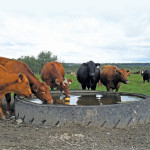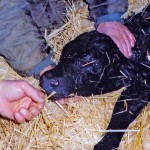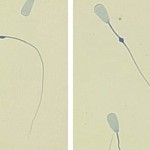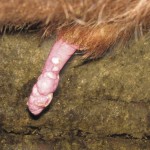Close attention to water quality can result in far better gains and health for livestock. It is often left out of the equation when discussing ways to increase production, and the last thing checked in disease investigations. Since the bovine is generally very tolerant of poor-quality water obvious health concerns may not arise yet subtle […] Read more

Check the quality of the water

Necrotic laryngitis or calf diphtheria (barker calves)
Veterinarians use various treatments depending on what they've found is most effective
I am sure most producers over the years have had calves develop a throat infection on a sporadic basis. These are the calves which have an extremely loud, inspiratory and expiratory sound which can be heard across the pen. They generally extended their neck to breathe and are in various forms of respiratory distress. The […] Read more

Some advice on when and how to resuscitate calves
Both dairy and beef producers have their own views on the best way to stimulate a weak calf that doesn’t want to breathe. Based on my experience of what works, and what doesn’t, the procedures worth doing do not require a lot of expense but saving one extra calf these days converts into significant dollars […] Read more

What can we do about mycoplasma?
When talking to feedlot owners and backgrounders across this country one question almost always comes up. “Is there anything new out there to combat mycoplasma?” While there are things being worked on it is not an easy fix. What we have found is there are procedures, vaccines combined with minimizing stress (often easier said than […] Read more
Common pitfalls with semen evaluations and how to avoid them
In the past 32 years of semen evaluating bulls I have come across many tricks of the trade to make this procedure run smoothly. Every situation is different and every set of bulls unique so most of these points involve common-sense observations that I have made over the years. Collecting an adequate semen sample from […] Read more

Droplets: A common defect in young bull evaluations
Cattle producers often question semen evaluation forms for young bulls that report a lot of proximal and distal droplets. They cause frustration because the bulls must be retested. Droplets are probably the most common defect seen by veterinarians when performing breeding soundness exams in the spring. We see more droplets on average in young immature […] Read more
Some advice on when and how to resuscitate calves
Both dairy and beef producers have their own views on the best way to stimulate a weak calf that doesn’t want to breathe. Based on my experience of what works, and what doesn’t, the procedures worth doing do not require a lot of expense but saving one extra calf these days converts into significant dollars […] Read more
Avoid allergic reactions
With only the rare occurrence of allergic reactions in cattle they are not mentioned much in the literature. However, today’s modern producers give more in the way of vaccines and antimicrobials. With longer-acting products that are only approved subcutaneously or intramuscularly and not intravenously the risk level is elevated. The carrier or base in the […] Read more
Do we need to worm livestock at turnout?
When getting ready to send cattle out to grass this spring one big question to ask yourself is, do they need to be dewormed? In the past with our avermectins or pour-on products seeming to be effective in the fall and no chance of reintroduction over the winter we thought levels should be almost zero […] Read more

Penile problems in bulls
Many can be caught and fixed at a yearling semen evaluation
When examining young bulls for the first time we as veterinarians look for many conditions besides semen quality that may affect breeding ability. Many of these can be corrected but some result in bulls being eliminated from the gene pool. Young bulls are more commonly detected with seminal vesiculitis and other infections involving secondary sex […] Read more


